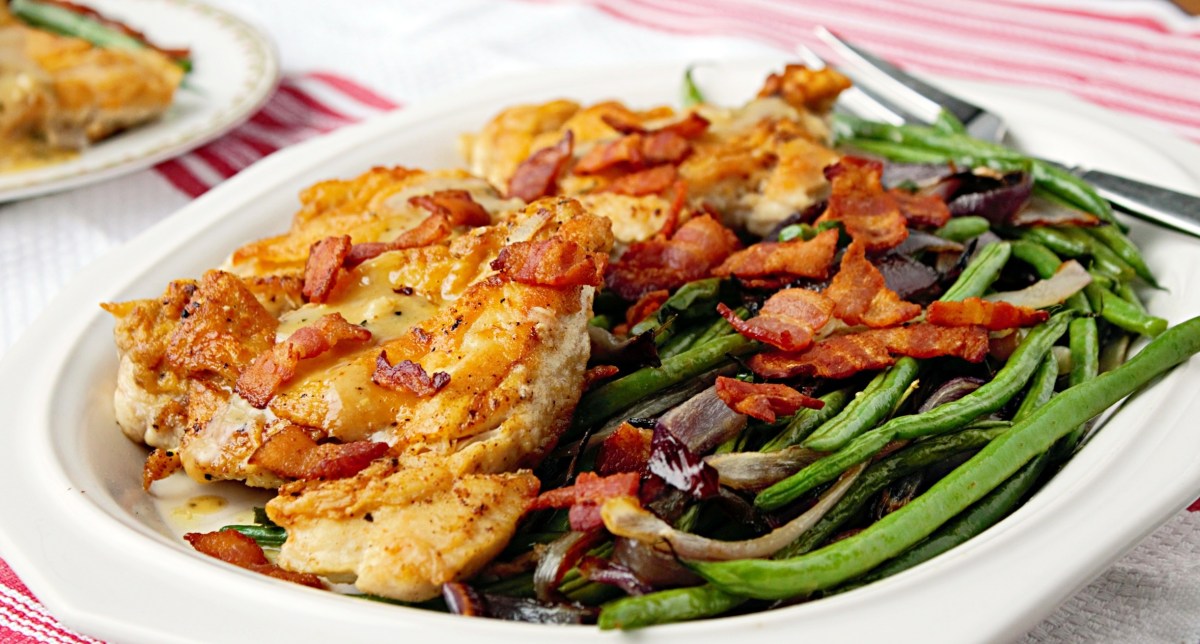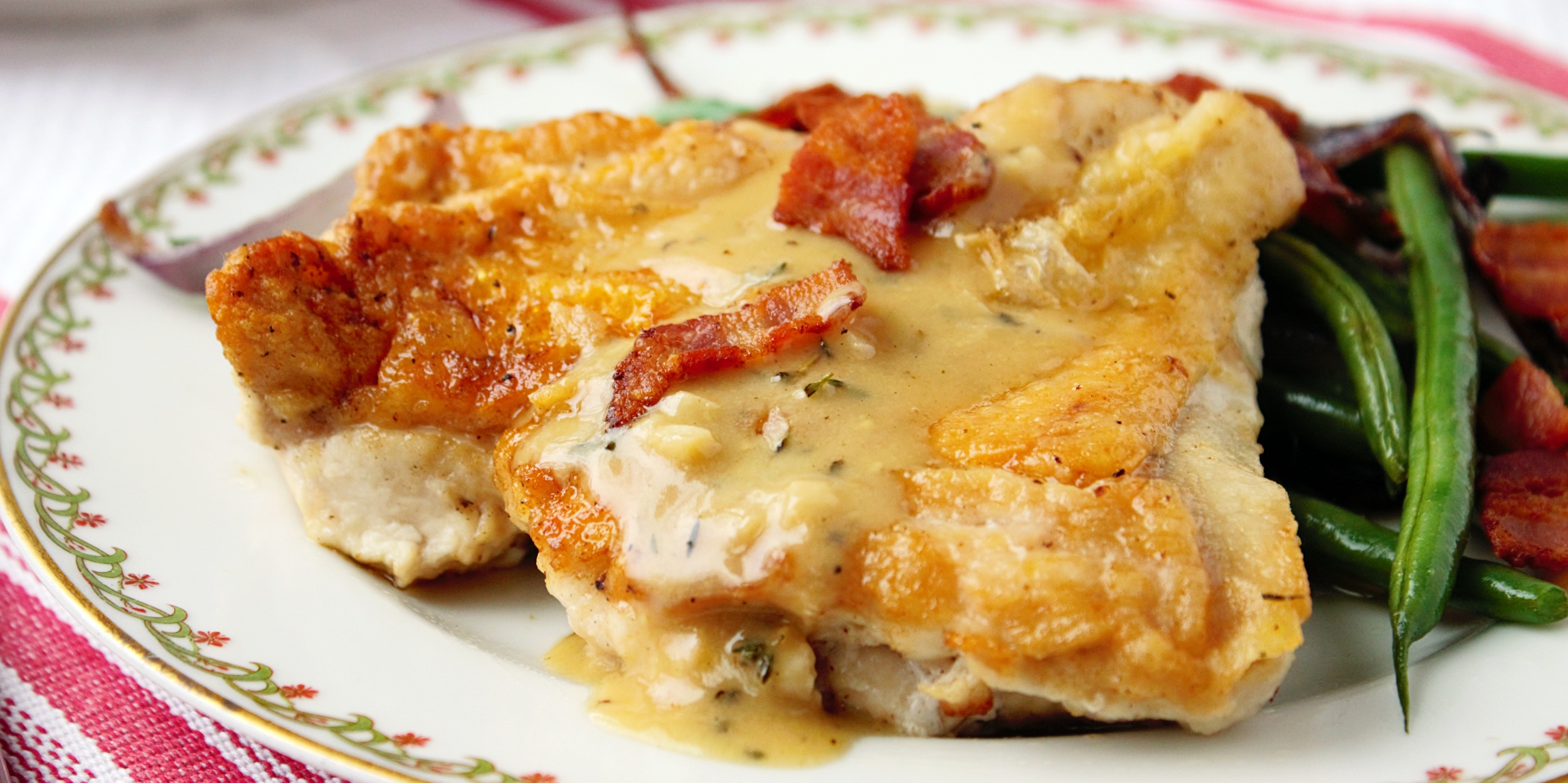Chicken Paillard is a fancy name for a boneless breast of chicken with skin. Can also be translated as “genius” and “why-isn’t-everyone-cooking-chicken-breasts-this-way”.
There will always be a place for boneless, skinless breasts - what would Chicken Piccata or Chicken Marsala be without them? But let’s be honest, you have to handle them with care or they can come out a little flavorless and dry. Chicken Paillard has all the advantages of a boneless breast - uniform thickness that cooks through evenly, and a flat edge that makes maximum contact with the cooking surface. But the skin - every inch of which gets golden and crispy because of that flat surface - adds tons of moisture and flavor. In this photo, below, I’ve captured the paillard before I drizzled it with sauce, so you can get a good look at that gorgeous, glistening skin.
To start, sear the Chicken Paillard in bacon drippings in a heavy pan such as a cast iron skillet. The fat and flavor left behind are the starting point for a silky and intensely flavorful pan sauce - a reduction of white wine, garlic, thyme and Dijon mustard, sweetened with a touch of honey and finished with a splash of heavy cream.
Meanwhile in the oven, red onions roast until they’re soft and sweetly caramelized. For the last few minutes of roasting, toss in fresh green beans. Serve the chicken on a bed of the onions and green beans, with the mustardy pan sauce drizzled over and the bacon pieces scattered on top.

You probably won’t find boneless breasts with skin at the meat counter. Buy bone-in breasts (also called split breasts) and either ask your butcher to bone them, or do it yourself at home. It’s quick work with a thin flexible knife, and you’re left with some nice bones to use for chicken stock.
Making this ahead and what to do with leftovers:
- For best results, make Chicken Paillard right before serving - the crispiness of the skin and the crisp-tender texture of the beans are at their best when they’re freshly cooked.
- If you have leftovers, the best method for reheating them is the oven. 400 degrees for 15 to 20 minutes, or until everything’s heated through and the chicken skin is revived.
Chicken Paillard with Roasted Green Beans and Red Onions
In the preparation of this recipe, some ingredients are prepared on the stovetop while at the same time others are roasting in the oven. The timing and coordination of the two processes is important, so that everything finishes at the same time. It’s not complicated, just read the whole recipe through before you start so you can plan ahead. Have all your ingredients prepped, chopped, ready to go. When you get to Step 6 there’s a good opportunity to take a pause and make sure everything’s in sync (and get caught up if it's not) before you proceed with the final steps.
Ingredients
- 4 ounces (4 slices of regular cut, not thick cut) bacon, cut into ¾-inch pieces
- 12 ounces (1 extra-large or 2 medium-large) red onions, peeled, halved vertically (through the stem end) and cut into ¾-inch wedges
- Extra virgin olive oil
- 3 pounds chicken breasts with skin and bone (2 to 4 breast halves depending on their size)
- Kosher salt
- Freshly ground black pepper
- 1/3 cup all-purpose flour
- 12 ounces fresh green beans, trimmed
- 2 garlic cloves, minced
- 1 teaspoon minced fresh thyme
- 1 cup white wine
- 2 tablespoons Dijon mustard
- 2 teaspoons honey
- 2 tablespoons heavy cream
Directions
- Step 1 Heat the oven to 400 degrees on the Roast setting.
- Step 2 Place a large cast iron or other heavy non-stick skillet over medium heat and put the bacon in the cold pan. (Make sure the skillet is big enough that it will hold all the chicken in a single layer when it’s time to add it.) As the bacon slowly heats, it will render its fat and then start to sizzle and brown. Cook the bacon, stirring frequently, until it’s crispy and browned, about 15 minutes.
- Step 3 As soon as you put the bacon in the pan, start the onions. Toss the onion wedges into a large roasting pan and drizzle them with enough olive oil to coat the onions and skim the bottom of the roasting pan with a thin layer of oil. Season with salt and pepper. Toss the onions until they’re evenly coated with the oil and the wedges are mostly broken up into individual slivers. Roast the onions for 20 minutes, stirring once halfway through.
- Step 4 While the onions and bacon cook, prepare the chicken. Use a thin, sharp knife to bone the chicken breasts, cutting as close to the bone as possible, without removing the skin. Remove the tenders (the finger-shaped piece on the underside of the breast closest to the bone) and reserve them for another use. Place the chicken breasts on a cutting board with the skin side up. Cover with plastic wrap and use a meat pounder to flatten the breasts. You’re not trying to get them super-thin, just pound them until they’re a uniform thickness, ¾ to 1 inch thick. If the breasts are very large, cut them in half or into serving-sized pieces. You should have at least four pieces. Turn the breasts flesh side up and season the flesh side with kosher salt and pepper. Spread the flour on a plate. Set the chicken and the plate of flour aside.
- Step 5 When the bacon is done, remove it to a paper-towel-lined plate using a slotted spoon. Leave the fat in the skillet and raise the heat under the skillet to medium-high. Dredge the chicken breast pieces lightly in the flour, patting off any excess. Arrange the chicken in the skillet in a single layer, skin side down, and cook it without moving or turning it until the skin is crispy and golden brown, 4 minutes. Turn and cook the flesh side for 1 minute. Remove the chicken to a plate, skin side up. Keep the skillet on the heat.
- Step 6 The onions should have been roasting for 20 minutes by this point. If they haven’t, let the chicken sit until the 20 minutes are up. If the onions reach 20 minutes before the chicken is out of the skillet, remove the roasting pan from the oven to a rack and let the onions sit. You want the onions to have roasted for 20 minutes and the chicken to be out of the skillet before proceeding with the green beans. If that’s where you are, then add the green beans to the roasting pan, drizzle them with additional olive oil to coat them, and season them with salt and pepper. Toss the onions and green beans together, then spread them out in an even layer. Return the pan to the oven and roast for 5 minutes. Add the garlic and thyme to the hot skillet and cook for 30 seconds, just until the garlic turns fragrant but don’t let it brown. Add the wine. Cook the wine over medium-high heat until it’s reduced to about 3 tablespoons.
- Step 7 After the green beans have been roasting for 5 minutes, add the chicken to the roasting pan, skin side up. Nestle the chicken in among the beans and onions, pushing the beans and onions aside so the flesh side of the chicken is directly on the pan. Return the pan to the oven and roast for 5 final minutes.
- Step 8 While the chicken, beans and onions finish roasting, finish the pan sauce. Remove the skillet from the heat. Whisk the Dijon mustard and honey into the reduced wine, then whisk in the heavy cream.
- Step 9 Transfer the beans and onions to a platter and arrange the chicken alongside. Drizzle the pan sauce over the chicken and sprinkle with bacon pieces on top.

